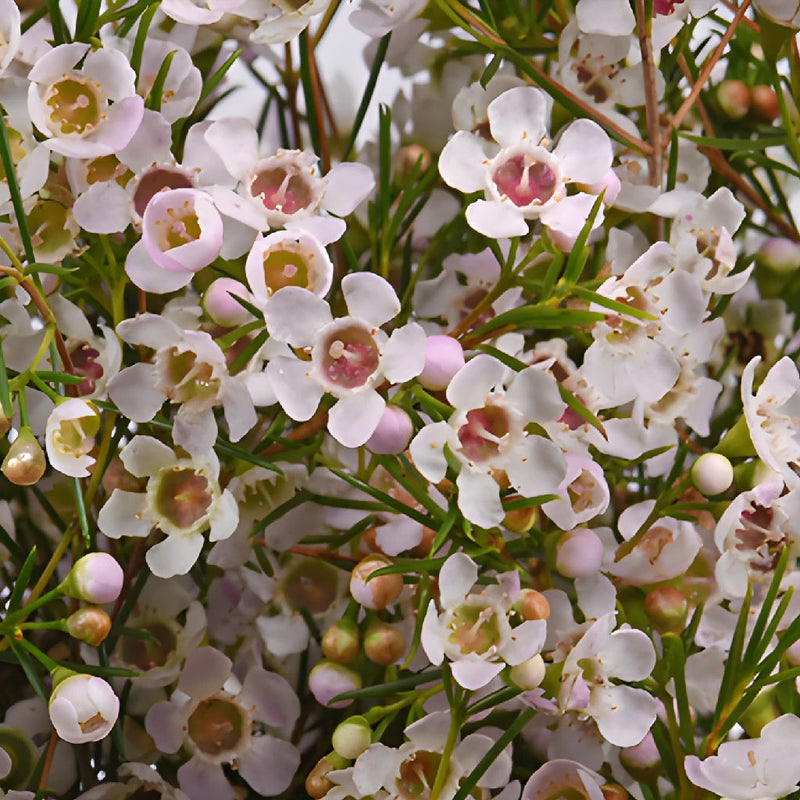Delicate yet enduring, Waxflower (Chamelaucium spp.) brings together charm and toughness in one bloom-laden shrub. Native to Australia, it’s known for its tiny, five-petaled flowers that resemble wax—hence the name. These flowers, often seen in shades of pink, purple, or white, add ethereal texture to floral arrangements and landscapes alike. Its fine, needle-like foliage adds to its airy, wild feel, making it both elegant and untamed.
Florists adore waxflower for its exceptional vase life and light fragrance. In the garden, it thrives with minimal attention and rewards growers with months of blooming beauty. Drought-tolerant and sun-loving, this plant is a reliable favorite for water-wise gardens and Mediterranean-style landscapes.

Portrait of the Waxflower
Part of the Myrtle family, waxflower includes several species such as Chamelaucium uncinatum, commonly known as Geraldton wax. Its popularity stems from both its decorative beauty and hardy nature.
- Type: Evergreen woody shrub
- Family: Myrtaceae
- Common Names: Waxflower, Geraldton Wax
Foliage and Form
Waxflower sports fine, aromatic foliage, resembling rosemary or heather. It forms a naturally airy, branching shape that works well in both formal and wild landscapes.
- Height: 1.5–3 m (5–10 ft)
- Spread: 1–2 m (3–6.5 ft)
- Growth Habit: Upright, bushy shrub with arching stems
Blooms and Fragrance
Small flowers with a waxy sheen bloom profusely from late winter into spring, attracting pollinators and adding soft color when few other plants are flowering.
- Bloom Time: Late winter to late spring
- Color: Pink, mauve, white, purple
- Fragrance: Light, sweet scent from blooms and foliage
The Right Time to Plant, Prune, and Enjoy Waxflower
| Month | Planting | Flowering | Pruning |
|---|---|---|---|
| January | ❌ | ✅ (early bloomers) | ✅ Light structural trim |
| February | ✅ (mild climates) | ✅ Peak | ✅ Light deadheading |
| March | ✅ Prime planting time | ✅ Peak bloom | ✅ Shaping after bloom |
| April | ✅ | ✅ Ending | ✅ Post-flower pruning |
| May | ✅ (cooler zones) | ❌ | ✅ Structural shaping |
| June | ❌ | ❌ | ✅ Light maintenance cuts |
| July | ❌ | ❌ | ❌ |
| August | ❌ | ❌ | ❌ |
| September | ✅ (new season prep) | ❌ | ✅ Dead branch removal |
| October | ✅ Excellent for transplanting | ❌ | ✅ Light tip pruning |
| November | ✅ Container-grown plants | ❌ | ✅ Formative trimming |
| December | ❌ | ✅ (early bloomers) | ✅ Light cleanup |
✅ = Recommended ❌ = Not advised
Watering, Sunlight, and Environment for Waxflower
Watering
Once established, waxflower is very drought-tolerant, making it ideal for low-maintenance gardens.
- When to Water: Weekly when young; biweekly when mature
- How Much: Deep waterings during dry periods
- Watch out for: Overwatering—waxflower dislikes soggy roots
Sunlight
This is a sun-lover. Full sunlight encourages dense growth and prolific flowering.
- Ideal Exposure: Full sun (6–8 hours daily)
- Shady Sites: Will result in poor flowering and lanky growth
- Best Location: Open borders, slopes, coastal gardens
Indoor vs Outdoor
Waxflower does best outdoors in well-ventilated, open locations. Indoor cultivation is possible in large containers with bright light.
- Best Location: Outdoor beds, xeriscapes, raised containers
- Avoid: Crowded or humid indoor spots
Temperature
Waxflower loves mild winters and hot, dry summers, thriving in Mediterranean climates.
- Optimal Range: 15–30°C (59–86°F)
- Hardiness Zones: USDA 9–11
- Protection Tip: Avoid frost—cover young plants in cold snaps
Ideal Soil Conditions for Growing Waxflower
| Soil Feature | Optimal Condition | Why It Matters |
|---|---|---|
| Soil Type | Sandy or loamy | Ensures proper drainage |
| Texture | Loose, coarse, well-aerated | Reduces risk of root rot |
| Drainage | Excellent drainage is essential | Prevents fungal disease |
| Moisture | Dry to slightly moist | Mimics native conditions |
| Soil pH | Slightly acidic to neutral (6.0–7.0) | Supports nutrient uptake |
| Fertility | Low to moderate | Avoid high nitrogen—encourages flowering |
Common Problems & Solutions
| Issue 🐾 | Symptoms 🔍 | Solutions 🛠️ |
|---|---|---|
| Root Rot 💧 | Wilting, yellow leaves | Improve drainage, reduce watering |
| Aphids 🐜 | Sticky residue, curled leaves | Use neem oil or insecticidal soap |
| Poor Bloom 🌱 | Lots of growth, few flowers | Ensure full sun, reduce nitrogen |
| Tip Dieback 🍂 | Browning stem tips | Prune and disinfect tools |
| Powdery Mildew 🌫️ | White film on leaves | Improve airflow, apply fungicide |
Waxflower brings subtle color, fragrance, and structure to the landscape, all while asking for very little. With its tough nature and delicate charm, it’s ideal for gardeners seeking a resilient yet refined shrub that thrives in sun-drenched spaces. Whether you’re cutting it for bouquets or enjoying its natural shape in the garden, waxflower is a blooming success waiting to happen.